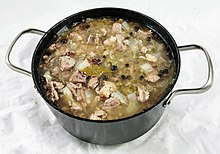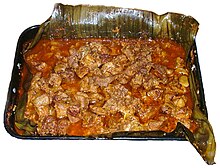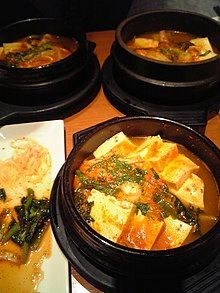What Type of Meat Is in Beef Stew
 Lamb and lentil stew | |
| Type | Stew |
|---|---|
| Chief ingredients | Vegetables (carrots, potatoes, onions, beans, mushrooms, etc.), meat, (such as beef) and a liquid such as water, wine, beer or stock |
| |
A stew is a combination of solid food ingredients that have been cooked in liquid and served in the resultant gravy. Ingredients in a stew can include whatever combination of vegetables and may include meat, specially tougher meats suitable for boring-cooking, such equally beef, pork, lamb, poultry, sausages, and seafood. While water tin be used as the stew-cooking liquid, stock is also common. A small amount of cherry-red vino is sometimes added for flavor. Seasoning and flavourings may also be added. Stews are typically cooked at a relatively depression temperature (simmered, not boiled), allowing flavours to mingle.

Stewing is suitable for the to the lowest degree tender cuts of meat that become tender and juicy with the tiresome moist rut method. This makes it pop in low-cost cooking. Cuts having a certain amount of marbling and gelatinous connective tissue give moist, juicy stews, while lean meat may hands become dry out.
Stews are thickened past reduction or with flour, either by coating pieces of meat with flour before searing, or past using a roux or beurre manié, a dough consisting of equal parts of fatty and flour. Thickeners like cornstarch, white potato starch, or arrowroot may also exist used.
Stews are similar to soups, and in some cases there may not be a articulate distinction between the 2. By and large, stews take less liquid than soups, are much thicker and require longer cooking over low heat. While soups are almost ever served in a bowl, stews may be thick enough to be served on a plate with the gravy as a sauce over the solid ingredients.[1]
History [edit]

Ohaw, Ainu fish and vegetables stew from northern Nihon
Stews have been fabricated since aboriginal times. The world's oldest known evidence of stew was found in Japan, dating to the Jōmon menstruum.[two] [3] Additionally, Herodotus says that the Scythians (8th to 4th centuries BC) "put the flesh into an brute's paunch, mix water with it, and boil it like that over the bone burn. The bones burn very well, and the paunch easily contains all the meat once it has been stripped off. In this way an ox, or any other sacrificial animate being, is ingeniously fabricated to eddy itself."[ commendation needed ]
Amazonian tribes used the shells of turtles every bit vessels, humid the entrails of the turtle and various other ingredients in them. Other cultures[ who? ] used the shells of big mollusks (clams etc.) to eddy foods in.[ commendation needed ] There is archaeological evidence[ where? ] of these practices going back viii,000 years or more.[ citation needed ]

There are recipes for lamb stews and fish stews in the Roman cookery volume Apicius, believed to engagement from the fourth century Ad. Le Viandier, one of the oldest cookbooks in French, written in the early 14th century by the French chef known every bit Taillevent, has ragouts or stews of various types in information technology.[4]
The start written reference to 'Irish gaelic stew' is in Byron'south "The Devil's Drive" (1814): "The Devil ... dined on ... a rebel or and then in an Irish gaelic stew."[5]
As part of the Eintopfsonntag campaign, from 1933 the Nazi party fabricated a midday Lord's day eintopf (stew) obligatory on some days:[6] in particular as part of the Winterhilfe, the get-go Sunday of the month from October until March was declared Eintopfsonntag.
Types [edit]

Meat-based white stews also known as blanquettes or fricassées are made with lamb or veal that is blanched or lightly seared without browning, and cooked in stock. Brown stews are made with pieces of crimson meat that are start seared or browned, earlier a browned mirepoix and sometimes browned flour, stock and vino are added. There also exists stew which tin be made without meat, this is eaten with other non-fleshy alternatives like Tofu.
List of stews [edit]


Claypot beefiness stew with potatoes and mushrooms





Dubu jjigae (Korean tofu stew)



A pork stew (ragoût de porc)
- Baeckeoffe, a white potato stew from Alsace
- Beef bourguignon, a French dish of beef stewed in carmine burgundy wine
- Beef Stroganoff, a stew with beefiness from Russian federation
- Bigos, a traditional stew in Smooth cuisine
- Birria, a traditional stew from United mexican states
- Bo Kho (Vietnamese: bò kho), a beefiness stew in rich seasonings, served with staff of life, noodle or plain rice from Vietnam
- Bollito misto, consisting of beef, veal, and pork simmered in an aromatic vegetable broth from Italy
- Booyah, an American meat stew
- Bosnian Pot, a stew with beefiness or lamb which is a national dish in Bosnia and Herzegovina
- Bouillabaisse, a fish stew from Provence
- Brongkos, a spicy Javanese meat with beans stew from Republic of indonesia, made of Pangium edule, coconut milk, and various spices
- Brunswick stew, from Virginia and the Carolinas
- Bouillon, a Kentuckian stew
- Brudet, fish stew from Dalmatia regions, known in Hellenic republic as bourdeto
- Caldeirada, a fish stew from Portugal
- Carbonade flamande (Stoofvlees), a traditional Belgian beef and onion stew made with Belgian beer
- Cawl, a Welsh stew
- Chakapuli, a Georgian stew made with lamb chops, coriander and tarragon leaves, and white vino
- Chanakhi, a Georgian lamb stew with tomatoes, aubergines, potatoes, greens, and garlic
- Charquicán, a Chilean dish
- Chankonabe, a Japanese dish flavoured with soy sauce or miso: Chankonabe is traditionally eaten by sumo wrestlers
- Chicken stew, whole chicken and seasonings
- Craven paprikash, craven stew with paprika
- Chili con carne, a meat and chili pepper stew originating in Texas
- Chilorio, a pork stew from Sinaloa, Mexico
- Cincinnati chili, developed by Macedonian immigrants from Hellenic republic immigrants in the Cincinnati expanse
- Cholent, a slow-cooked Jewish dish
- Chorba (besides spelt "Shorba"), a stew like soup dish plant in various North African, Middle Eastern, Central Asian, South Asian, and European cuisines
- Cochinita pibil, an orangish color pork stew from Yucatán Peninsula, Mexico
- Cocido, a traditional Spanish and Portuguese strew with many variants (madrileño, montañés, à portuguesa, etc.)
- Cotriade, a fish stew from Brittany
- Cream stew, a yōshoku Japanese white stew
- Crow stew, a sour cream-based stew fabricated with crow meat, pop in the United States during the Great Depression
- Daal, the Indian legume stew that has many varieties, a staple food throughout Asia
- Dalma, a traditional dish of Orrisha, India, comprise pulses with vegetable
- Daube, a French stew made with cubed beefiness braised in wine, vegetables, garlic, and herbs
- Dinuguan, pork blood stew from the Philippines
- Eintopf, (1 pot) the High german discussion for a stew: many different regional specialty recipes for Eintopf are known in Germany; for example, the Kassel area has a type chosen Lumben un Fleeh in the local dialect (Standard German: Lumpen und Flöhe - rags and fleas), which is quite similar to Irish stew. There are thicker German stews such as Hasenpfeffer or Labskaus; these would not usually be considered an Eintopf, though the technical difference is pocket-sized (longer cooking times and fewer vegetables)
- Ewedu, vegetable stew from Nigeria
- Fabada asturiana, an Asturian bean and meat stew
- Feijoada, Brazilian or Portuguese bean stew
- Fårikål, traditional Norwegian stew with lamb or mutton and white cabbage
- Főzelék, a thick Hungarian vegetable dish
- Gaisburger Marsch, a German dish of stewed beef served with Spätzle and potatoes
- Gheimeh, an Iranian stew with cubed lamb and yellow split peas
- Ghormeh sabzi, an Iranian stew with green herbs, stale limes, beans, and sheep meat
- Casserole, a Hungarian meat stew with paprika
- Gumbo, a Louisiana creole dish
- Hachee, a Dutch type of stew with wine or vinegar
- Haleem, an Indian - Pakistani lentil and beef stew
- Hasenpfeffer, a sour, marinated rabbit stew from Germany
- Hayashi rice, a Japanese dish of beef, onions and mushrooms in red wine and demi-glace sauce, served with rice
- Irish gaelic stew, made with lamb or mutton, murphy, onion, and parsley
- Ishtu, a back-scratch in Kerala, Republic of india made from chicken or mutton, murphy, and coconut milk[7]
- Istrian stew or yota, or jota, a dish pop in Croatian and Slovene Istra and NE Italy
- I-tal Stew, a Rastafarian vegan dish of generally Caribbean root vegetables and spices
- Jjigae, a diverse range of Korean stews
- Kalops, a traditional Swedish beef stew, with onions and carrots, served with potatoes and pickled beets
- Kare-kare, stewed beefiness or oxtail and vegetables in peanut sauce from the Philippines
- Karelian hot pot, from the region of Karelia in eastern Finland
- Kharcho is a traditional Georgian soup containing beef, rice, cherry plum purée, and chopped walnuts
- Khash, a traditional Armenian/Azerbaijani dish of pig's or moo-cow'due south feet [8]
- Khoresht, a multifariousness of Western farsi stews, often prepared with saffron
- Kokkinisto, Greek stew with red meat, in a tomato passata with shallots, cinnamon, and other spices
- Kuurdak, a blazon of stew from Central Asia
- Lapskaus, a Norwegian stew with beef, spud, onion, and carrot
- Lancashire hotpot, an English stew
- Lecsó, a summertime favourite in Hungary, vegetable stew with bell pepper and tomato as chief ingredients
- Linseneintopf ("lentil stew")
- Lobby, a stew from Staffordshire, England
- Locro, a stew (mainly in the Andes region)
- Machanka, a Belarus and Ukraine pork stew
- Matelote, a French fish stew fabricated with freshwater fish, fish stock, and vino
- Mechado, a Philippine beef stew
- Moppelkotze
- Moqueca, a Brazilian stew with fish (or shrimp, crab, or other seafoods) every bit its main ingredient
- Mućkalica, a Serbian stew
- Nihari, a Pakistani beef stew fabricated overnight and served for breakfast
- Nikujaga, a Japanese beef and irish potato stew
- Oil down, national dish of Grenada, made of breadfruit, salted meat, chicken, dumplings, callaloo, coconut milk, spices
- Olla podrida, a Spanish reddish bean stew
- Pašticada, a Croatian stew from the region of Dalmatia
- Peperonata, an Italian stew made with peppers
- Pepposo, a Tuscan beefiness stew
- Pescado Blanco, a white fish stew from Pátzcuaro, Michoacán, Mexico
- Pichelsteiner a traditional German stew
- Pörkölt, a Hungarian meat stew resembling goulash, flavoured with paprika
- Potjiekos, a South African stew
- Pot-au-feu, a simple French beefiness stew
- Pozole, a Mexican stew or soup
- Puchero, a stew from Andalusia, Kingdom of spain, also common in Due south America and the Philippines
- Pulusu, is a course of stew from Andhra Pradesh in Bharat that is typically sour and cooked with tamarind paste
- Ratatouille, a French vegetable stew
- Ragoût de Porc, a French pork stew
- Sambar, a thick vegetable stew, from South India
- Sancocho, a stew from the Caribbean
- Scouse, a stew commonly eaten by sailors throughout Northern Europe, popular in seaports such as Liverpool
- Semur, a typical Indonesian stew with beef or chicken, potatoes, carrots, various spices, and kecap manis (sweet soy sauce) from Indonesia
- Steckrübeneintopf (based on rutabaga)
- Slumgullion, a watery stew of meat and vegetables
- Tagine, a Moroccan stew, named after the conical pot in which it is traditionally cooked or served
- Tocană, a Romanaian stew prepared with tomato, garlic, and sweetness paprika
- Tharid, a traditional Arab stew of staff of life in broth
- Waterzooi, a Belgian stew
- Yahni, a Greek (γιαχνί), Turkish, and Persian stew
See also [edit]
- Braising
- Casserole
- Back-scratch
- Hot pot
- Jugging
- List of foods
- Nabemono
- Perpetual stew
- Pottage
- Soup
References [edit]
- ^ Soup vs. stew: Difference in details | The Journal Gazette Archived August 11, 2011, at the Wayback Machine
- ^ BBC - A History of the World - About: Transcripts - Episode ten - Jomon pot
- ^ Globe's Oldest Pottery Used to Melt Fish in Japan | JOMON Food | Facts and Details
- ^ "Taillevent, Viandier (Manuscrit du Vatican)". www.staff.uni-giessen.de . Retrieved 2017-01-27 .
- ^ Byron, George Gordon Byron Baron (1891-01-01). The Poetical Works of Lord Byron: With Memoir and the Original Explanatory Notes, &c. F. Warne and Visitor.
- ^ Frost, Natasha (12 April 2018). "The Forgotten Nazi History of 'One-Pot Meals'". Atlas Obscura . Retrieved 10 July 2018.
- ^ Koshi Ishtu – Kerala Craven Stew Recipe – Food.com – 265726
- ^ Leo M.L. Nollet; Fidel Toldra (1 April 2011). Handbook of Analysis of Edible Fauna By-Products. CRC Printing. pp. 9–. ISBN978-1-4398-0361-v.
External links [edit]
| | Wikimedia Commons has media related to Stews. |
| | Look upwards stew in Wiktionary, the free dictionary. |
- Stew recipes. Nutrient.com.
- Jäger-Eintopf (hunter'south Stew) Recipe
- Recipe for Zürcher Eintopf
greercommayfuland.blogspot.com
Source: https://en.wikipedia.org/wiki/Stew
Post a Comment for "What Type of Meat Is in Beef Stew"